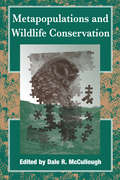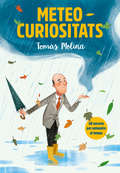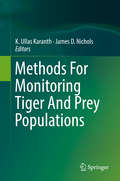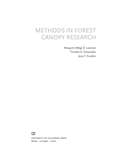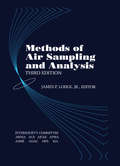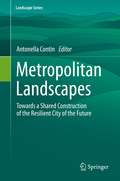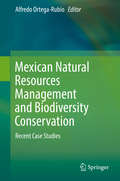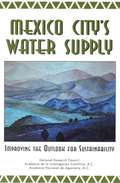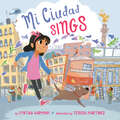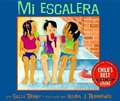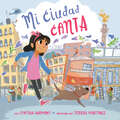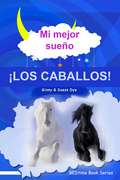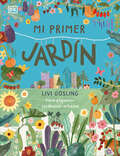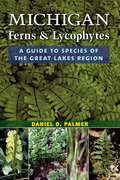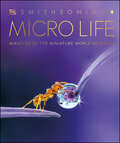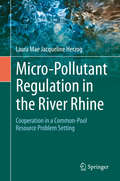- Table View
- List View
Metanarrative and the Environment: A Story of Morality, Agency, and Governance (Routledge Research in Environmental Policy and Politics)
by Stephen James PurdeyTo meet the challenge of global environmental degradation activists have tackled clear and concrete problems such as carbon emissions and climate change, the ruination of ecosystems and habitat, the precipitous loss of biodiversity, and many other unhappy consequences of irresponsible human behaviour. However, all such efforts to manually correct the course of history have been dwarfed by the magnitude and heavy forward momentum of modern industrial society. In Metanarrative and the Environment, Stephen James Purdey argues that material approaches to the environmental crisis cannot succeed without the power of a legitimating discourse – a new metanarrative – which fundamentally changes the ideational landscape of human development. Dr. Purdey begins in Part I by establishing the pragmatics of our environmental predicament – its roots and responses to it. He focuses on the concept, definition, and key features of metanarrative, introducing the hegemonic story that now rules the contemporary global mindscape. Part II takes on the moral problematic more directly, encouraging the evolution of a new metanarrative by bringing our potential for agency in the face of danger into sharper relief. Metanarrative and the Environment is multidisciplinary, with a particular emphasis on the creative humanities. It will be of interest to undergraduate and graduate students alike, as well as environmental activists and academics looking for a new way forward.
Metaphors for Environmental Sustainability: Redefining Our Relationship with Nature
by Brendon LarsonScientists turn to metaphors to formulate and explain scientific concepts, but an ill-considered metaphor can lead to social misunderstandings and counterproductive policies, Brendon Larson observes in this stimulating book. He explores how metaphors can entangle scientific facts with social values and warns that, particularly in the environmental realm, incautious metaphors can reinforce prevailing values that are inconsistent with desirable sustainability outcomes. Metaphors for Environmental Sustainabilitydraws on four case studies--two from nineteenth-century evolutionary science, and two from contemporary biodiversity science--to reveal how metaphors may shape the possibility of sustainability. Arguing that scientists must assume greater responsibility for their metaphors, and that the rest of us must become more critically aware of them, the author urges more critical reflection on the social dimensions and implications of metaphors while offering practical suggestions for choosing among alternative scientific metaphors.
Metapopulations and Wildlife Conservation
by Dale Richard Mccullough Jonathan Ballou Glen Woolfenden Bradley Stith F. Lance Craighead Bill PrantyDevelopment of rural landscapes is converting once-vast expanses of open space into pockets of habitat where wildlife populations exist in isolation from other members of their species. The central concept of metapopulation dynamics -- that a constellation of partially isolated patches can yield overall stability to a system that is chaotic at the level of the individual patch -- offers an important new way of thinking about the conservation and management of populations dispersed among small habitat fragments. This approach is proving to be a rich resource for biologists hoping to arrest the current catastrophic loss of biodiversity.This volume provides a comprehensive overview of the subject, addressing the needs of an applied professional audience for comprehensible information to integrate into their practices. Leading conservation biologists, ecologists, wildlife managers, and other experts consider the emergence and development of metapopulation theory and explore its applicability and usefulness to real-world conservation programs. Conservation is essential reading for anyone working in the field of wildlife conservation and management.
Meteocuriositats: 50 secrets per entendre el temps
by Tomàs Molina Roger SimóConverteix-te en un meteoròleg expert amb el Tomàs Molina! Per què el cel és blau? Com podem saber si plourà? Com es forma l'arc de Sant Martí? De què estan fets els núvols? Per què els trons fan tant soroll? Segur que moltes vegades has mirat al cel i has pensat que el temps està boig... Però no! La realitat és que cada fenomen meteorològic té una explicació científica, curiosa i divertida. Estàs preparat per descubrir-la?
Meteoros (¡Arriba la Lectura!, Level M #24)
by Chantal Stewart Heather Hammonds¡Mira! ¡Ahí, arriba, en el cielo! ¡Es una nube de polvo! ¡Es un grupo de rocas! ¡Es un meteoro! Lee para saber todo acerca de cómo el polvo y las rocas que atraviesan la atmósfera a gran velocidad se combinan para crear fantásticos destellos de luz en el cielo nocturno. NIMAC-sourced textbook
Methodological Challenges in Nature-Culture and Environmental History Research (Routledge Environmental Humanities)
by L. Anders Sandberg Jocelyn Thorpe Stephanie RutherfordThis book examines the challenges and possibilities of conducting cultural environmental history research today. Disciplinary commitments certainly influence the questions scholars ask and the ways they seek out answers, but some methodological challenges go beyond the boundaries of any one discipline. The book examines: how to account for the fact that humans are not the only actors in history yet dominate archival records; how to attend to the non-visual senses when traditional sources offer only a two-dimensional, non-sensory version of the past; how to decolonize research in and beyond the archives; and how effectively to use sources and means of communication made available in the digital age. This book will be a valuable resource for those interested in environmental history and politics, sustainable development and historical geography.
Methods For Monitoring Tiger And Prey Populations
by K. Ullas Karanth James D. NicholsThis book addresses issues of monitoring populations of tigers, ungulate prey species and habitat occupancy, with relevance to similar assessments of large mammal species and general biodiversity. It covers issues of rigorous sampling, modeling, estimation and adaptive management of animal populations using cutting-edge tools, such as camera-traps, genetic identification and Geographic Information Systems (GIS), applied under the modern statistical approach of Bayesian and likelihood-based inference. Of special focus here are animal survey data derived for use under spatial capture-recapture, occupancy, distance sampling, mixture-modeling and connectivity analysees. Because tigers are an icons of global conservation, in last five decades,enormous amounts of commitment and resources have been invested by tiger range countries and the conservation community for saving wild tigers. However, status of the big cat remains precarious. Rigorous monitoring of surviving wild tiger populations continues to be essential for both understanding and recovering wild tigers. However, many tiger monitoring programs lack the necessary rigor to generate the reliable results. While the deployment of technologies, analyses, computing power and human-resource investments in tiger monitoring have greatly progressed in the last couple of decades, a full comprehension of their correct deployment has not kept pace in practice. In this volume, Dr. Ullas Karanth and Dr. James Nichols, world leaders in tiger biology and quantitative ecology, respectively, address this key challenge. The have collaborated with an extraordinary array of 30 scientists with expertise in a range of necessary disciplines - biology and ecology of tigers, prey and habitats; advanced statistical theory and practice; computation and programming; practical field-sampling methods that employ technologies as varied as camera traps, genetic analyses and geographic information systems. The book is a 'tour de force' of cutting-edge methodologies for assessing not just tigers but also other predators and their prey. The 14 chapters here are lucidly presented in a coherent sequence to provide tiger-specific answers to fundamental questions in animal population assessment: why monitor, what to monitor and how to monitor. While highlighting robust methods, the authors also clearly point out those that are in use, but unreliable. The managerial dimension of tiger conservation described here, the task of matching monitoring objectives with skills and resources to integrate tiger conservation under an adaptive framework, also renders this volume useful to wildlife scientists as well as conservationists.
Methods in Environmental Forensics
by Stephen M. MudgeWhile environmental catastrophes can be naturally occurring, often they are the result of criminal intent or malfeasance. Sorting out the details when the land itself is the only witness requires a special set of investigative skills. For accountability to be established, investigators must be able to answer these questions with a measure of scient
Methods in Forest Canopy Research
by Margaret D. Lowman Timothy D. Schowalter Jerry F. FranklinPoised between soil and sky, forest canopies represent a critical point of exchange between the atmosphere and the earth, yet until recently, they remained a largely unexplored frontier. For a long time, problems with access and the lack of tools and methods suitable for monitoring these complex bioscapes made canopy analysis extremely difficult. Fortunately, canopy research has advanced dramatically in recent decades. Methods in Forest Canopy Research is a comprehensive overview of these developments for explorers of this astonishing environment. The authors describe methods for reaching the canopy and the best ways to measure how the canopy, atmosphere, and forest floor interact. They address how to replicate experiments in challenging environments and lay the groundwork for creating standardized measurements in the canopy--essential tools for for understanding our changing world.
Methods of Air Sampling and Analysis
by Jr., James LodgeIncludes precise directions for a long list of contaminants! All contaminants you can analyze or monitor with a given method are consolidated together to facilitate use. This book is especially valuable for indoor and outdoor air pollution control, industrial hygiene, occupational health, analytical chemists, engineers, health physicists, biologists, toxicologists, and instrument users.
Metropolitan Landscapes: Towards a Shared Construction of the Resilient City of the Future (Landscape Series #28)
by Antonella ContinThis edited volume covers many aspects of the Metropolitan Landscapes. Solutions are needed to meet the demand of the citizens of a renewed metropolitan region landscape. It opens up discussions about possible toolkits for strategic actions based on understanding the territory from geographical, urban, architectural, economic, environmental, and public policy perspectives. This book intends to promote the Metropolitan dwelling quality, ensuring human well-being proposing a discussion on the resilient articulation of the interface space among the city's infrastructure, agriculture, and nature.This book results from the Symposium: Metropolitan Landscapes that MSLab of the Politecnico di Milano and ETSA (Sevilla) organized at the IALE 2019 Conference (Milan, July 2019) to manage radical territory transformation with a strategic vision. The widespread growth of urban areas indicates the importance of building resilient sustainable cities capable of minimizing climate-change impact production.The Symposium aimed to discuss the Urban Metabolism approach considering the combination of Landscapes set in a single Metropolitan Ecosystem. Accordingly, new design strategies of transformation, replacement or maintenance can compose Urban-Rural Linkage patterns and a decalage of different landscape contexts. Ecological interest in environmental sustainability, compatibility, and resilience is not tied exclusively to the balance between production and energy consumption. Thus, it is the integration over time and at several scales of the urban and rural landscapes and their inhabitants that nourish the Metropolitan Bioregion.Moreover, the Metropolitan Landscape Book's research hypothesis is the need for a Glossary, strengthening the basis of understanding Metropolitan Landscape's complexity.This book's topic is particularly relevant to Landscape Urbanism, Architecture, Urban disciplines Scholars, Students and Practitioners who want to be connected in a significant way with Metropolitan Discipline’s research field.
Mexican Natural Resources Management and Biodiversity Conservation: Recent Case Studies
by Alfredo Ortega-RubioThis book presents valuable and recent lessons learned regarding the links between natural resources management, from a Socio-Ecological perspective, and the biodiversity conservation in Mexico. It address the political and social aspects, as well as the biological and ecological factors, involved in natural resources management and their impacts on biodiversity conservation. It is a useful resource for researchers and professionals around the globe, but especially those in Latin American countries, which are grappling with the same Bio-Cultural heritage conservation issues.
Mexico City's Water Supply: Improving the Outlook for Sustainability
by The Joint Academies Committee on the Mexico City Water SupplyThis book addresses the technical, health, regulatory, and social aspects of ground water withdrawals, water use, and water quality in the metropolitan area of Mexico City, and makes recommendations to improve the balance of water supply, water demand, and water conservation. The study came about through a nongovernmental partnership between the U.S. National Academy of Sciences National Research Council and the Mexican Academies of Science and Engineering. The book will contain a Spanish-language translation of the complete English text.
Mi Ciudad Sings
by Cynthia HarmonyAfter experiencing a devastating earthquake, the spirit of a charming and vibrant Mexican neighborhood might be shaken, but it cannot be broken.As a little girl and her dog embark on their daily walk through the city, they skip and spin to the familiar sounds of revving cars, clanking bikes, friendly barks, and whistling camote carts. But what they aren't expecting to hear is the terrifying sound of a rumbling earthquake...and then...silence. With captivating text and lively, beautiful illustrations, this heartwarming story leaves readers with the message that they can choose to be strong and brave even when they are scared, and can still find joy and hope in the midst of sadness.
Mi ciudad canta
by Cynthia HarmonyDespués de vivir un temblor devastador, el espíritu de los vecinos en esta dinámica zona de la ciudad Mexicana se sacude, pero no se rompe. Una pequeña niña y su perro se aventuran en su caminata diaria por la ciudad; brincan y giran con el sonido familiar de coches acelerando, de bicicletas rechinando, de amigables ladridos, y de los silbidos del carrito de camotes. Pero lo que no esperan es escuchar el escalofriante estruendo de un temblor… y después…silencio. Con un texto cautivador y hermosas ilustraciones, esta cálida y reconfortante historia permite a los lectores reconocer que se puede escoger ser valientes y fuertes aún cuando se tiene miedo, y encontrar alegría y esperanza en medio de la tristeza. After experiencing a devastating earthquake, the spirit of a charming and vibrant Mexican neighborhood might be shaken, but it cannot be broken. As a little girl and her dog embark on their daily walk through the city, they skip and spin to the familiar sounds of revving cars, clanking bikes, friendly barks, and whistling camote carts. But what they aren't expecting to hear is the terrifying sound of a rumbling earthquake...and then...silence. With captivating text and lively, beautiful illustrations, this heartwarming story leaves readers with the message that they can choose to be strong and brave even when they are scared, and can still find joy and hope in the midst of sadness.
Mi mejor sueño ¡LOS CABALLOS!
by Ginny Suess DyeMi mejor sueño ¡LOS CABALLOS! Autor: Ginny & Suess Dye Ilustrador: Iqra Abdullah Sueños para la hora de dormir Serie# 1 Más de la serie de libros ¡Cuando sueño, sueño con cachorritos! ¡Cuando sueño, sueño con LODO, LODO, LODO! Cuando sueño, sueño con gatitos Cuando sueño, sueño con elefantes Cuando sueño, sueño con pájaros Cuando sueño, sueño con nieve Cuando sueño, sueño con el océano Cuando sueño, sueño con la jungla Cuando sueño, sueño con una granja Cuando sueño, sueño con postres Y MUCHOS más… Copyright 2017 por Greywacke Publishing ISBN# 1974095592 Publicado por Greywacke Publishing Seattle, WA www.MyBestEverDreams.com www.GreyWackePublishing.com
Mi primer jardín (My First Series)
by Livi GoslingUn primer libro de jardinería para niños, con divertidos proyectos y actividades, para que los más pequeños aprendan a cuidar el medioambiente jugando y disfruten de su pasión por las flores y las plantas.Los niños descubrirán cómo preparar la tierra antes de sembrar, qué y cuándo plantar, dónde conseguir semillas, cómo trasplantar, podar y hacer compost, qué verduras y hierbas cultivar. ¡Todo lo necesario para crear increíbles espacios verdes y llenar de color y aromas tu casa, balcón o jardín!Perfecto para aprender cómo crecen las plantas y tener un primer contacto con el huerto o el jardín.Con texto sencillo, instrucciones paso a paso y divertidas ilustraciones.Ideal para fomentar el respeto por la naturaleza y el medioambiente.¡Enseña a tus hijos a sembrar, plantar, regar y cuidar de las plantas y observa como ser convierten en auténticos jardineros!----------------------This is the perfect gardening book for kids who want to plant fruit and vegetables, create mini-farms from plants, and go on wildflower missions.No matter how tiny your space, you can be a gardener. Livi Gosling has advice on creating places for plants to live in your home, scavenging from the recycling to create a vegetable kingdom, and adding a splash of color to grey city streets with your own wildflower seed mix.This great gardening book for children features: Livi&’s striking illustrations that make this book a keepsake as well as a practical guide.Kid-friendly text makes the topic fun and encourages a sense of wonder at nature.A strong eco message.With clear step-by-step instructions on how to get seeds, plant them, and help them grow, and plenty of inspiration andhelpful tips, this nature book teaches children the basics for growing different plants, from gorgeous flowers to delicious fruit and vegetables.
Miami in the Anthropocene: Rising Seas and Urban Resilience
by Stephanie WakefieldReimagining adaptation amidst climate change–driven mutations of urban space and life Between its susceptibility to flooding and an ever-expanding real estate market powered by global surges of people and capital, Miami is an epicenter of the urban Anthropocene and a living laboratory for adaptation to sea level rise. Miami in the Anthropocene explores the social, environmental, and technical transformations involved in climate adaptation infrastructure and imaginaries in a global city seen as climate change ground zero. Using Miami as a compelling microcosm for understanding the complex interplay between urbanization and environmental upheaval in the twenty-first century, Stephanie Wakefield shows how &“aqua-urban futures&” are being imagined for the city, from governmental scenario exercises for severe weather events to proposals to transform the city&’s metropolitan area into an archipelago of islands connected by bridges. She examines the shifts reweaving the fabric of urban life and presents designs that imagine dramatic new ways of living with water. Grounded in the dynamic landscape of Miami but reaching far beyond its shores, Miami in the Anthropocene delves into the broader debates shaping urban thought and practice in the Anthropocene. Focusing on postresilience urban designs, Wakefield illuminates the path toward a future where cities embrace opportunities for evolution rather than merely for survival.
Michael Recycle Meets Litterbug Doug (Michael Recycle)
by Ellie BethelDoug is a litterbug living on a pile of garbage till he meets Michael.
Michigan Ferns and Lycophytes: A Guide to Species of the Great Lakes Region
by Daniel D PalmerMichigan’s ferns and lycophytes are among the state’s most fascinating plants. The species in these groups exhibit incredibly diverse life cycles and an amazing array of morphology. Some species such as the Bracken fern are widespread and aggressive, dominating forest understories throughout much of northern Michigan, while other species are exceedingly rare and adapted to life solely in harsh niche habitats where little else can grow. Unlike the well-studied flowering plants and gymnosperms, Michigan’s ferns and lycophytes have long lacked a reliable, up-to-date guidebook, and this book fills that gap. Covering all 120 taxa found in the state, it features detailed keys, species descriptions, and range maps alongside precise illustrations. Readers learn about the etymology of species’ common and scientific names as well as interesting facts about their historic uses by humans and place within the Michigan ecosystem. The book also provides information on the challenging taxonomy of many ferns and lycophytes, with special attention given to the species likely to hybridize and those prone to misidentification. This is a must-have reference for anyone who wishes to learn about these important components of the Great Lakes flora.
Michigan Shrubs and Vines: A Guide to Species of the Great Lakes Region
by Burton V. Barnes Melanie Gunn Christopher DickShrubs and vines are some of the most diverse and widespread plants in the Great Lakes Region. Michigan Shrubs and Vines is the must-have book for anyone who wishes to identify and learn about these fascinating plants. Presented in the same attractive, easy-to-use format as the classic Michigan Trees, the book gives detailed descriptions of 132 species, providing concise information on key characters, habitat, distribution, and growth pattern. Precise line drawings accompany each species description and illustrate arrangement and characteristics of leaves, flowers, and fruits in addition to stem structure to assist with reliable year-round identification. A thorough introduction covers the features and forms of shrubs and vines as well as their natural history, their role in landscape ecosystems, and their occurrence in regional ecosystems of North America and plant communities of the Great Lakes. This long awaited companion to Michigan Trees will appeal to botanists, ecologists, students, and amateur naturalists alike.
Micro Life: Miracles of the Miniature World Revealed (DK Secret World Encyclopedias)
by DKExplore the miracles of the microscopic world.Find out all about the unique and beautiful kingdoms of life at a microscopic scale and how every organism meets the challenges of survival no matter its size. The perfect book for people who enjoy photography, nature and biology.Inside the pages of this exciting educational nature book, you&’ll find: • Microscopic life-forms (often neglected), and their life-forms in extreme close-ups, revealing details such as nerve cells and hair follicles. • Artworks support the beautiful images, providing a deeper insight into structure and function and building a picture of how living organisms work at a microscopic level. • Comprehensive coverage of the natural world, including all the main groups of living things. • Explores overlooked groups that have a huge role in the natural world: insects, which make up 80% of the world&’s animal species, and bacteria — of which there are more in a human mouth than there are people in the world. • The book is organized according to the main functions of life: movement, reproduction, energy and feeding, sensing the surroundings, defense, etc. • Optional 80-page section containing a catalog of the major kingdoms of life. The beauty of nature under a microscopeExplore the inhabitants of an invisible world in incredible detail with this book, which contains macro photography and spectacular microscope imagery. You'll have so much information about the hidden world of intricate structures beyond the naked eye. From the tiniest spiders and insects to even microscopic creatures like bacteria and viruses, this book contains it all!See the beauty of a pollen grain, a butterfly egg, the spore of a fungus and a human&’s nerve cell in extreme close up. The amazing imagery in Micro Life contains focus-stacked macro photographs and micrographs (microscope images), including scanning electron micrographs. Illustrations in this book explain the science — from the workings of an insect&’s eye to how a plant &“breathes&” through its leaves. Micro Life is an unexpectedly breathtaking look at the natural world. Find out how life works and how organisms solve the fundamental problems of movement, reproduction, energy, communication and defense. This book belongs on the bookshelves of schools, libraries and homes for those interested in photography, nature or biology.
Micro-Pollutant Regulation in the River Rhine: Cooperation in a Common-Pool Resource Problem Setting
by Laura Mae HerzogThis book investigates how actors organize in order to solve a water quality problem. Research on the use of environmental resources has mainly focused on the circumstances needed for users to self-organize or to maintain an already sustainable way of resource use. Few studies have investigated the reasons why actors start to cooperate when they are faced with an environmental problem. Actor networks in three regions of the Rhine catchment area are scrutinized regarding a) actors’ cooperation pattern when managing an environmental problem; and b) the factors that trigger actors in a common-pool resource situation to initiate cooperation. Water quality policy is analysed in two European countries – Germany and Luxembourg – and one non-European country - Switzerland –, providing an overview of the distinctive measures applied in these regions aiming to tackle the water quality problem of micro-pollutants in river surface water. Applying the social-ecological system framework (SESF) devised by E. Ostrom and her colleagues and Social Network Analysis (SNA), the current book combines qualitative and quantitative methods to answer the question of why actors cooperate in the management process of an environmental problem like water pollution.


